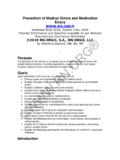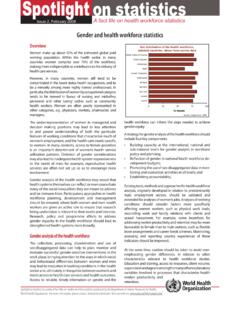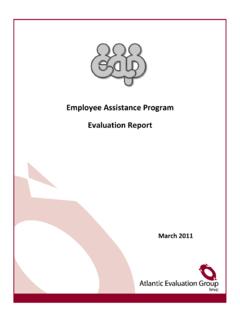Transcription of Cultural Competence in Healthcare - - RN.org®
1 Cultural Competence in Healthcare Reviewed May, 2017, Expires May, 2019 Provider Information and Specifics available on our Website Unauthorized Distribution Prohibited 2017 , , , LLC By Melissa Slate, RN, BSN Objectives By the end of this educational encounter, the clinician will be able to: Identify Cultural barriers to providing Healthcare Apply behaviors to enhance Cultural competency Recognize common beliefs of Cultural and ethnic groups that may impact Healthcare Introduction The purpose of this article is to give nurses and Healthcare clinicians an overview of issues and problems in delivering quality culturally competent Healthcare among diverse ethnic groups; and to assist the clinician with background knowledge to enhance the clinician s personal ethnic Healthcare delivery. Cultural Competence in Healthcare is a term used to reflect the ability to provide effectual medical care to persons of divergent ethnic backgrounds.
2 Cultural Competence is exercised through a balanced combination of appropriate knowledge, skills, attitudes, and behaviors (Clark, 2008). Culture- the interrelated patterns of human behavior that comprise language, thoughts, communications, actions, customs, beliefs, values, and institutions of racial, ethnic, religious, or social groups. Competence -effective function as either and individual or organization accounting for Cultural beliefs, behaviors, and needs of various Cultural and ethnic groups. Fostering Cultural Competence within oneself as a Healthcare clinician allows for effective communication, understanding, and interaction across divisions of language, social, or ethnic groups. There are 4 components of Cultural Competence : Awareness of ones Cultural view of the world Ones own attitude toward Cultural differences Knowledge of different Cultural views and practices Cross Cultural skills Medical literature is supporting the premise that Cultural Competence is equated with clinical Competence .
3 This makes the rationale for Cultural competency to be improved quality outcomes in care delivery, especially in areas of health care disparity (Clark, 2008). Causes of disparity in Healthcare can be divided into three areas: systems of care, patient and communities, and Healthcare providers. Systems of care: These include factors on both the state and federal levels such as health insurance and coverage, location and accessibility of Healthcare facilities, and availability of transportation. Patient and Communities: Patients in minority communities may have lifestyles that promote some diseases and contribute to the progression of illness. Some patients may not be as compliant with medical care due to varied levels of health literacy, lack of trust in Healthcare providers, and the use of alternative medicine. Studies have shown that minorities delay seeking medical care, refuse recommended services, and follow poor treatment regimens.
4 However, studies have revealed that factors from patients and communities are not the cause of the majority of Healthcare disparity. Healthcare providers: Doctors and other Healthcare providers can make disparities in Healthcare delivery by unconscious differences in the clinical decisions that they make. These decisions are influenced by their Cultural views and can only be dealt with by exploring and examining ones bias, stereotyping, and clinical uncertainty in providing care to patients of diverse backgrounds (Clark,2008). A culturally competent approach to Healthcare improves medication compliance and patient satisfaction. Other benefits include improved access to and utilization of Healthcare services, and the improvement in quality of care through the removal of Healthcare disparities. There are three levels of barriers that have been identified that need to be addressed in order to provide culturally competent Healthcare : clinical, structural, and organizational.
5 Demonstrating Cultural Competence Within Healthcare Organizations 1. Diverse workforce reflecting patient population 2. Healthcare facilities convenient to community 3. Language assistance available for patients with limited English proficiency 4. Ongoing staff training regarding delivery of culturally and linguistically appropriate services 5. Quality of care tracked across racial, ethnic, and Cultural subgroups 6. Community included in setting priorities and planning, delivery, and coordination of care Demonstrating Cultural Competence Within Provider-Patient Interpersonal Communication 1. Explores and respects patient beliefs, values, meaning of illness, preferences, and needs 2. Builds rapport and trust (clark,2008) 3. Establishes common ground 4. Is aware of own biases or assumptions 5. Maintains and is able to convey unconditional positive regard 6.
6 Is knowledgeable about different cultures 7. Is aware of health disparities and discrimination affecting minority groups 8. Effectively uses interpreter services when needed Bias There are 3 mechanisms by which Healthcare clinicians add to Cultural disparities: Unfamiliarity with non-verbal cues when interacting with persons of different cultures or ethnic and social groups. Biases Stereotypes Research studies have shown that Healthcare providers unconsciously stereotype persons based on race, class, physical disability, gender, age, and sexual orientation. These stereotypes influence clinical decision-making and the interpretation of symptoms. Multiple strategies are available to address the effects of unconscious bias. Bias training: evidence suggests that when Healthcare providers receive training on Cultural bias, the heightened awareness itself reduces bias.
7 Self-reflection: involves being aware of ones assumptions during a clinical encounter. Individualization v/s categorization - Involves seeing the individual persons unique traits as they actually are as opposed to seeing the person as a category that they belong to. This action suppresses stereotypes and enhances the clinical encounter. Perspective taking and affective empathy- Considering situations from the perspective of the patient hinders stereotypical thinking and allows for empathy for the patient s situation. Partnership Building- When clinicians attempt to see others as being of the same group stereotyping is reduced. In other words, instead of seeing race or gender, but viewing the other as being a member of your team, then the impact of stereotypes is reduced. When a trusting relationship is not formed between a clinician and a patient, the patient may feel as though the clinician is interrogating him or her when gathering information or during the history portion of the assessment.
8 Patients tend to be more comfortable with setting talk such as informal questions about clothing being worn or current events or weather. Clinicians however, are usually more comfortable with contextual talk and may jump right to asking questions, which may drive the patient to feel as though they are being judged. Another area that can hinder communication between clinician and patient is the area of stigmatization. Within certain groups, some subjects may be viewed with stigma or viewed as subjects not to be openly discussed such as sexual orientation, depression, drug or alcohol use, or genitourinary problems. The clinician must be sensitive to subtle verbal and non-verbal cues that the patient may be exhibiting in order to cross these communication barriers. The clinician should also attempt to elicit the patient s expectations about their visit and treatment plan.
9 Patients who visit the doctor about the onset of new headache symptoms and have unspoken concerns that the symptoms may mean they have a brain tumor, are more likely to leave dissatisfied and distrusting of the provider if they receive a prescription for high blood pressure medication because the provider believes the cause of the headache is related to the patient s high blood pressure. This also places the patient at risk for noncompliance with the medication regimen. There are two tools to help the clinician explore the patient s thoughts and arrive at a treatment plan that is satisfactory for both the patient and the clinician. Kleinman's questions: What do you think has caused your problem? Why do you think it started when it did? What do you think your sickness does to you? How severe is your sickness? Will it have a short or long course? What kind of treatment do you think you should receive?
10 What are the most important results you hope to receive from this treatment? What are the chief problems your sickness has caused for you? What do you fear most about your sickness? LEARN: Listen with sympathy and understanding to the patient's perception of the problem Explain your perceptions of the problem Acknowledge and discuss the differences and similarities in perceptions Recommend treatment Negotiate treatment Language Barriers Language is increasingly becoming more of a factor in quality Healthcare delivery. As the country becomes bilingual and multi- Cultural , the need to enhance and enable communication across language barriers becomes more imperative. Non-English speaking patients report more dissatisfaction with the care that they receive and are more likely to receive sub-optimal care. They are also less likely to: Receive preventive care Have a regular source of primary care Receive timely eye, dental, and physical examinations Receive error-free medical care Visit their clinician Return for follow-up visits after being seen in the emergency department.














